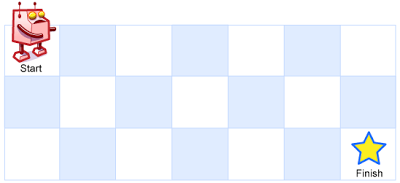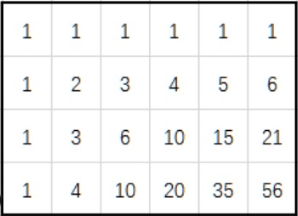[LeetCode] 62. Unique Paths
A robot is located at the top-left corner of a m x n grid (marked 'Start' in the diagram below).
The robot can only move either down or right at any point in time. The robot is trying to reach the bottom-right corner of the grid (marked 'Finish' in the diagram below).
How many possible unique paths are there?
Example 1:

Input: m = 3, n = 7 Output: 28
Example 2:
Input: m = 3, n = 2 Output: 3 Explanation: From the top-left corner, there are a total of 3 ways to reach the bottom-right corner: 1. Right -> Down -> Down 2. Down -> Down -> Right 3. Down -> Right -> Down
Example 3:
Input: m = 7, n = 3 Output: 28
Example 4:
Input: m = 3, n = 3 Output: 6
Constraints:
1 <= m, n <= 100- It's guaranteed that the answer will be less than or equal to
2 * 109.
不同路径。
一个机器人位于一个 m x n 网格的左上角 (起始点在下图中标记为 “Start” )。
机器人每次只能向下或者向右移动一步。机器人试图达到网格的右下角(在下图中标记为 “Finish” )。
问总共有多少条不同的路径?
来源:力扣(LeetCode)
链接:https://leetcode.cn/problems/unique-paths
著作权归领扣网络所有。商业转载请联系官方授权,非商业转载请注明出处。
题意是一个机器人位于一个 m x n 网格的左上角 (起始点在下图中标记为“Start”)。机器人每次只能向下或者向右移动一步。机器人试图达到网格的右下角(在下图中标记为“Finish”)。问总共有多少条不同的路径。
这一题也是 DP 的基础题,一定要掌握。这里我提供三种做法,
- 自上而下(自上而下又叫递归 + memo)
- 自下而上
- 节省空间的自下而上
DP自上而下
时间O(mn)
空间O(mn)
Java实现
1 class Solution { 2 int[][] memo; 3 4 public int uniquePaths(int m, int n) { 5 memo = new int[m][n]; 6 return dp(m - 1, n - 1); 7 } 8 9 private int dp(int i, int j) { 10 if (i == 0 && j == 0) { 11 return 1; 12 } 13 if (i < 0 || j < 0) { 14 return 0; 15 } 16 if (memo[i][j] > 0) { 17 return memo[i][j]; 18 } 19 memo[i][j] = dp(i - 1, j) + dp(i, j - 1); 20 return memo[i][j]; 21 } 22 } 23 24 // dp自上而下
DP自下而上,先确定矩阵边缘上的点的DP值,然后再考虑中间的点
时间O(mn)
空间O(mn)
Java实现
1 class Solution { 2 public int uniquePaths(int m, int n) { 3 int[][] dp = new int[m][n]; 4 dp[0][0] = 1; 5 for (int i = 1; i < m; i++) { 6 dp[i][0] = 1; 7 } 8 for (int j = 1; j < n; j++) { 9 dp[0][j] = 1; 10 } 11 for (int i = 1; i < m; i++) { 12 for (int j = 1; j < n; j++) { 13 dp[i][j] += dp[i - 1][j]; 14 dp[i][j] += dp[i][j - 1]; 15 } 16 } 17 return dp[m - 1][n - 1]; 18 } 19 } 20 // dp自下而上
节省空间的一维 DP。一维 DP 的思路是逐行扫描。首先初始化一个长度为 n 的数组,并初始化第一个坐标为 1(也就是坐标上0, 0的位置)。接着往右边扫描,每一个坐标的值是当前位置的 DP 值 + 他左边一个位置的 DP 值。根据下图跑一下代码,第7行,第一遍跑的时候,一开始 res[j] = res[1] = 0 + res[0] = 0 + 1 = 1;接着 res[2] = 0 + 1 = 1。以此类推得到第一行的dp值是 [1, 1, 1, 1, 1, 1]。再遍历第二行,得到 [1, 2, 3, 4, 5, 6];第三行 [1, 3, 6, 10, 15, 21] 和第四行 [1, 4, 10, 20, 35, 56]。这个思路非常巧妙,需要多多体会。
时间O(mn)
空间O(n)

Java实现
1 class Solution { 2 public int uniquePaths(int m, int n) { 3 int[] res = new int[n]; 4 Arrays.fill(res, 1); 5 for (int i = 1; i < m; i++) { 6 for (int j = 1; j < n; j++) { 7 res[j] += res[j - 1]; 8 } 9 } 10 return res[n - 1]; 11 } 12 } 13 // 节省空间的自下而上
JavaScript实现
1 /** 2 * @param {number} m 3 * @param {number} n 4 * @return {number} 5 */ 6 var uniquePaths = function (m, n) { 7 let res = new Array(n).fill(0); 8 res[0] = 1; 9 for (let i = 0; i < m; i++) { 10 for (let j = 1; j < n; j++) { 11 res[j] = res[j] + res[j - 1]; 12 } 13 // console.log(res); 14 } 15 return res[n - 1]; 16 };
相关题目



